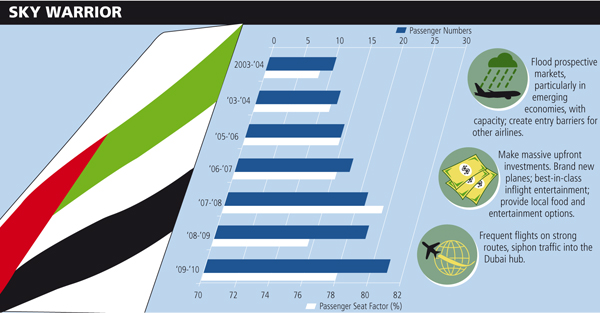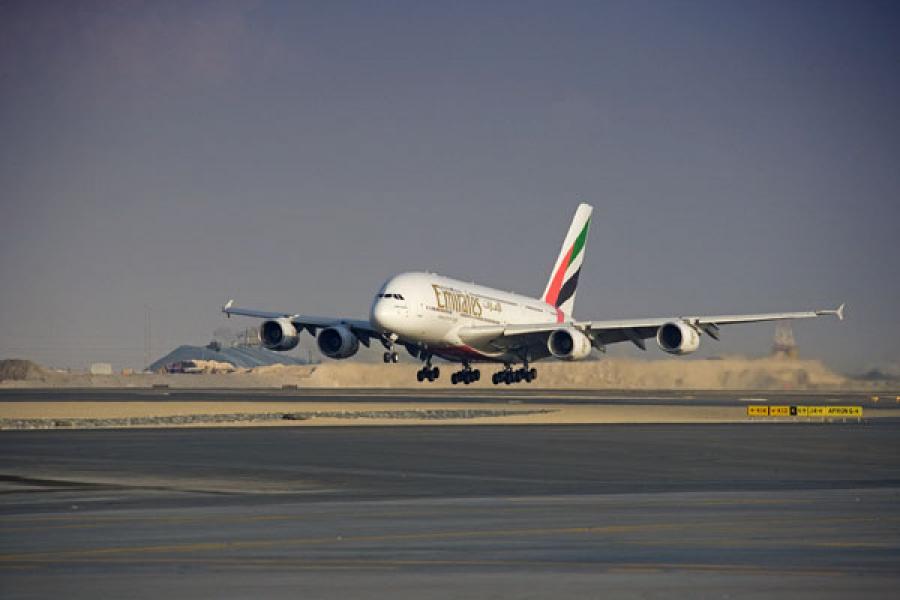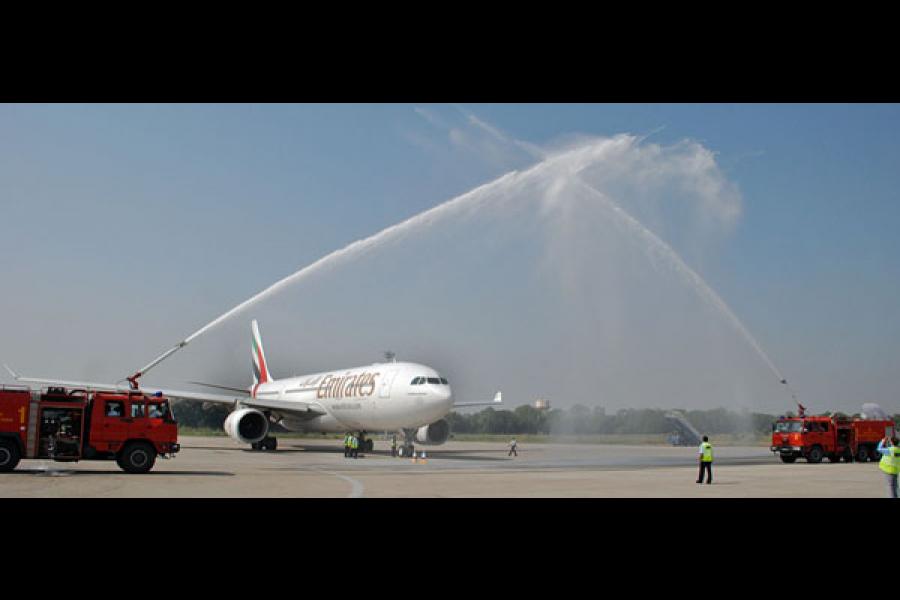
Emirates: Spoiling For a Fight
Sheikh Ahmed Al-Maktoum's Emirates airline is threatening to shake up the world order in the skies
During World War II, the skies of Europe witnessed plenty of dogfights between the Allies and the Axis. The second week of June 2010 saw the start of another, although no planes will be shot down here. Emirates airline chairman and CEO, Sheikh Ahmed bin Saeed Al-Maktoum, challenged Lufthansa, Europe’s largest airline, on its home ground.
Emirates offers more seats than Air France and British Airways (BA) combined on many intercontinental routes, despite a very small home market. With the huge new capacity on order, the writing is on the wall for European flag carriers. Half-way around the world in India, Emirates has worked pretty much the same way. In the last two years, it has grown its network to ten cities, building a formidable and competitive market presence. Emirates now operates 185 flights a week into India, as opposed to Air India’s 179. Constrained only by Indian government-restrictions on starting newer stations and flights, it is hungry for more.
For many in the travel business, in terms of passenger preference and network, Emirates is effectively India’s new national carrier. Head to head, the Air-India group, with Indian Airlines and Air India Express, has a higher number of international flights. But Emirates is adding new connections every month (Prague and Baghdad in July and Madrid from August). In contrast, Air India has been shrinking operations, in its fight to stay alive. From Dubai, Emirates connects to over 100 cities all over the globe compared to AI’s network of about 30 odd global cities connected from India. Even stronger European airlines like Lufthansa, British Airways and Air France — which used to eat Air India’s lunch by carrying west-bound Indian passengers to their big hubs — are now nursing black eyes with Emirates beating them at their own game.
Ready Before Demand Arises
From a two plane operation in 1985, Emirates has moved up the pecking order by steadily investing in capacity. The huge double-decker A380s ordered in Berlin, each of which can carry 550 passengers, will add many new seats on key routes such as London to Dubai. It is seenas a turning point for the airline industry. The new capacity assumes hundreds of new flights, which can only come from a more liberalised global airline regulation. Airlines like Emirates are pushing for this opening up, a process being resisted mostly by older carriers.Fresh capacity often pushes down fares. Emirates fares are already up to 50 percent cheaper than those offered by European rivals on transatlantic routes. The additional capacity offered by the A380s could make it difficult for flag carriers such as BA to compete on some segments. The flights through Dubai have already made some traditional routes operated by BA, Virgin Atlantic and other European carriers uncompetitive. For instance, the “Kangaroo Route” from Europe to Australia via Singapore or Bangkok, has been affected by the arrival of the three Gulf carriers Emirates, Qatar and Etihaad. The combination of more competition and a recession has forced both BA and Virgin to cut capacity on their Australia services.
 Illustration: Hemal Seth
Illustration: Hemal Seth Australian aviation think-tank Capa (Centre for Asia-Pacific Aviation) has been keenly following the airline boom in the Middle East and has published several reports analysing the impact. Capa India head Kapil Kaul says, ``the aviation business and Emirates airline are strategic to Dubai Inc.’’ India is probably the most important geographic segment for the airline, not just in terms of funnelling traffic into Dubai, but also as a source of cheap, talented manpower, he says. Capa expects Emirates to take equity in Indian carriers when government regulations allow it.
European airlines and the Indian carriers have decided that the only way to protect their market is by joining hands. Air India will soon be part of Star Alliance, feeding into a club that includes Lufthansa, Air Canada and United Airlines. Kingfisher has joined another alliance Oneworld, with British Airways and Cathay Pacific as sponsors.
Dubai Inc, on the other hand, has flanked the lower-end of the market with FlyDubai, a Dubai-government owned low-cost carrier which started flying to India this month. Emirates airlines, however, remains focused on the premium and middle segment the market. Though the promoters are common, the two operate as separate entities. Emirates’ promotions and advertising are proof of this. The new campaign focuses on attracting first and business class travellers, with free hotel stays in the new Armani hotel at the Burj in Dubai. “About 30 percent of the Indian traffic is premium class customers,” says Majid Al-Mualla, senior vice-president commercial operations, Emirates. Economy class passengers get help with visa helpdesks and free tickets for children if both parents are travelling. For thousands of Indian passengers every day of the week, EK and DXB, the IATA code (Emirates and Dubai), are the gateway to the world.
Dubai Factor
One of the reason’s for EK’s success is that so many Indians love transiting via Dubai,’’ says Madhav Oza, proprietor of Blue Star Travels, one of the biggest travel consolidators in Mumbai, who sells Emirates seats as well as those of rival airlines. The shopping, easy visas and simply the familiarity with the city often makes them choose it over colder and more congested European hubs like Frankfurt, Paris or Brussels, he says. So going via Dubai has become an attractive option, even if you are travelling to Australia or Africa.
Well aware of this, Dubai is building its infrastructure ahead of time. While environment and noise-restrictions have stalled several airport projects in the West, construction has begun on what is intended to be the world’s largest airport at Jebel Ali. The Dubai World Central-Al Maktoum International will have five runways and be able to cope with 180 million passengers a year. The first runway of the airport is due to open next year. However, analysts say the timing could be very critical. The Emirates could be saddled with huge excess capacity if the global economy takes a few wrong turns.
One of the most common criticisms about Emirates is that it owes its success to oil money and subsidies from the Dubai government. The airline and Sheikh Ahmed have always denied this. The airline has started declaring audited results, in what financial circles think is a precursor to an initial public offering. Profits for the year ended March were $964 million.
Subsidy or not, Emirates has benefited hugely by having Dubai as a hub. The airport is open 24 hours a day, and is operated by a sister company. It works in tandem with the airline to draw passengers from all over the world. And this is quite a contrast to the European or even the Indian airports, hemmed inside busy cities with curfew times restricting air traffic. Editorial director of American airline trade magazine Air Transport World, Perry Flint, does not believe the Dubai government secretly subsidises the airline. “The government has simply understood the importance of a strong national airline to the economy, rather than paying lip service like in other countries’’, he says. Rather than viewing Emirates as a cash cow, to be milked for taxes, the government has provided all the tools the airline needs — a massive airport with no curfew and low costs, a low or no tax environment to keep taxes down, laws that make it easy to import foreign labour an aggressive negotiation of routes on behalf of Emirates and a credit rating backed by the state (which is not so good today).
Video on Demand
Emirates has often been called a ‘Route machine’, because of the new points being connected every year. But frequent fliers say mileage points are not the only reason for choosing the carrier. Movies count too. “Emirates had TVs on all seats in 1992,” says Patrick Brannelly, vice president for passenger communications and visual services.
Patrick’s designation reflects the change in in-flight options, which now include phone, text and email. “We thought other airlines would follow in two or three years. But it took most of our rivals a good eight to ten years to have personal televisions,” he recalls.
Travellers can use their mobile phones to make calls and text from the flights. Opinion was divided about whether this would be intrusive to other passengers, but Brannelly says the experiment has gone well and it is just like using mobiles in any other public place.
The in-flight entertainment equipment is the most expensive component of the plane after the engines. It costs anywhere from $10,000 - $15,000 per seat to install the system on a plane, he says When they began; IFE had six channels, today there are more than 1,200. From options of 15-20 movies, it is now video on demand, with hundreds of options. Movies in Hindi, Malayalam, German, French and other languages are available not only within a particular geography, but across the network on all flights.
Kaul predicts that the Emirates network in India will only grow stronger over the next few years as Indian carriers simply do not have the strong balance sheet needed to compete.
But it will not be so easy in the rest of the world. Emirates is growing its network in Europe—it connects to 19 cities. But the large European carriers have a footprint in dozens of cities in North and South America, something Emirates is some way from achieving. For instance, it connects to only four cities in the United States, as opposed to Lufthansa’s 22 North American gateways.
The latest order is another bold move in a world where most airlines are taking severe hits on their profits.
But Sheikh Ahmed knows that to win a dogfight, you have to be on the top.
(This story appears in the 02 July, 2010 issue of Forbes India. To visit our Archives, click here.)
Post Your Comment
Comments 1
-
 D.D.
D.D.Quite nice piece
on Jun 28, 2010
















